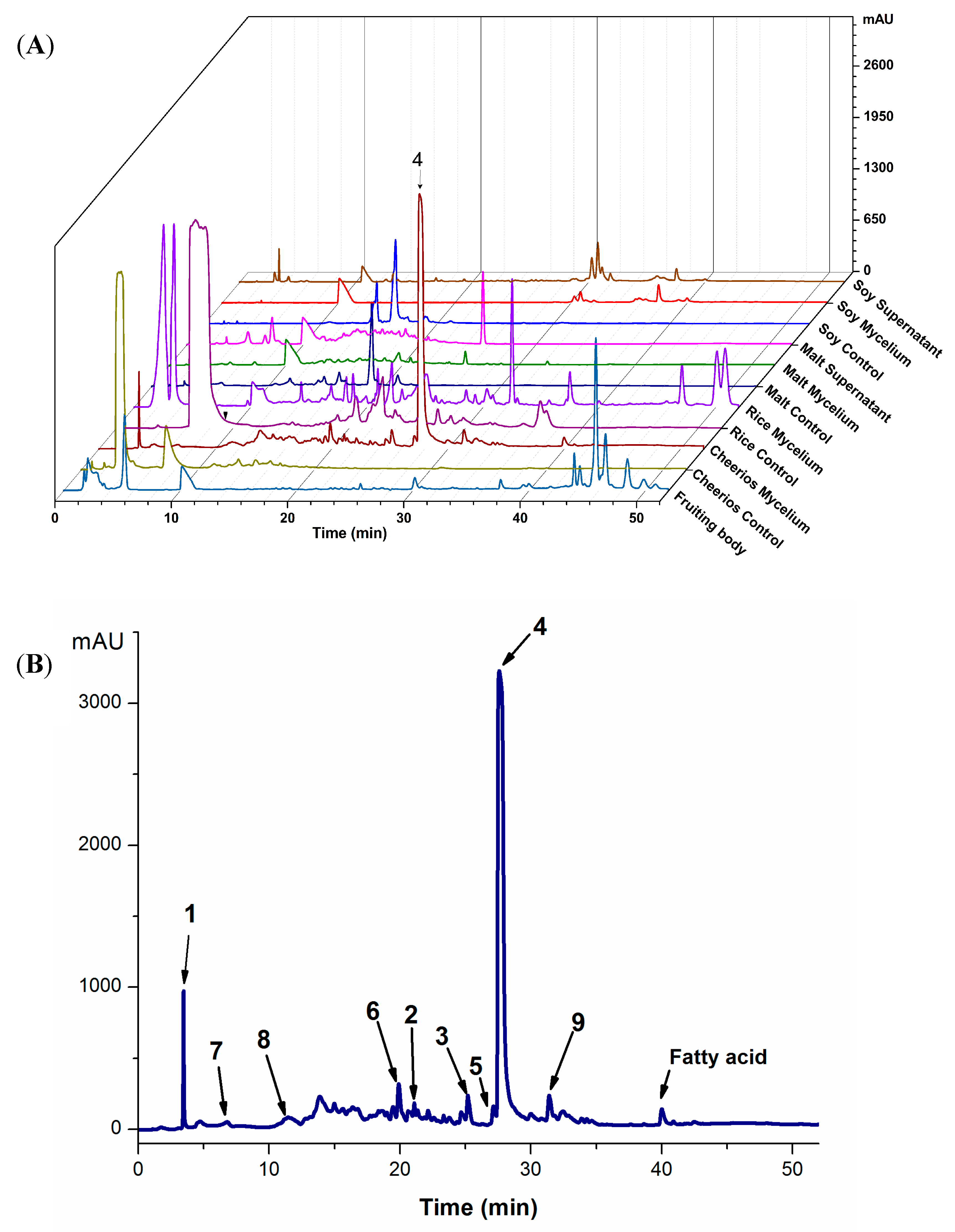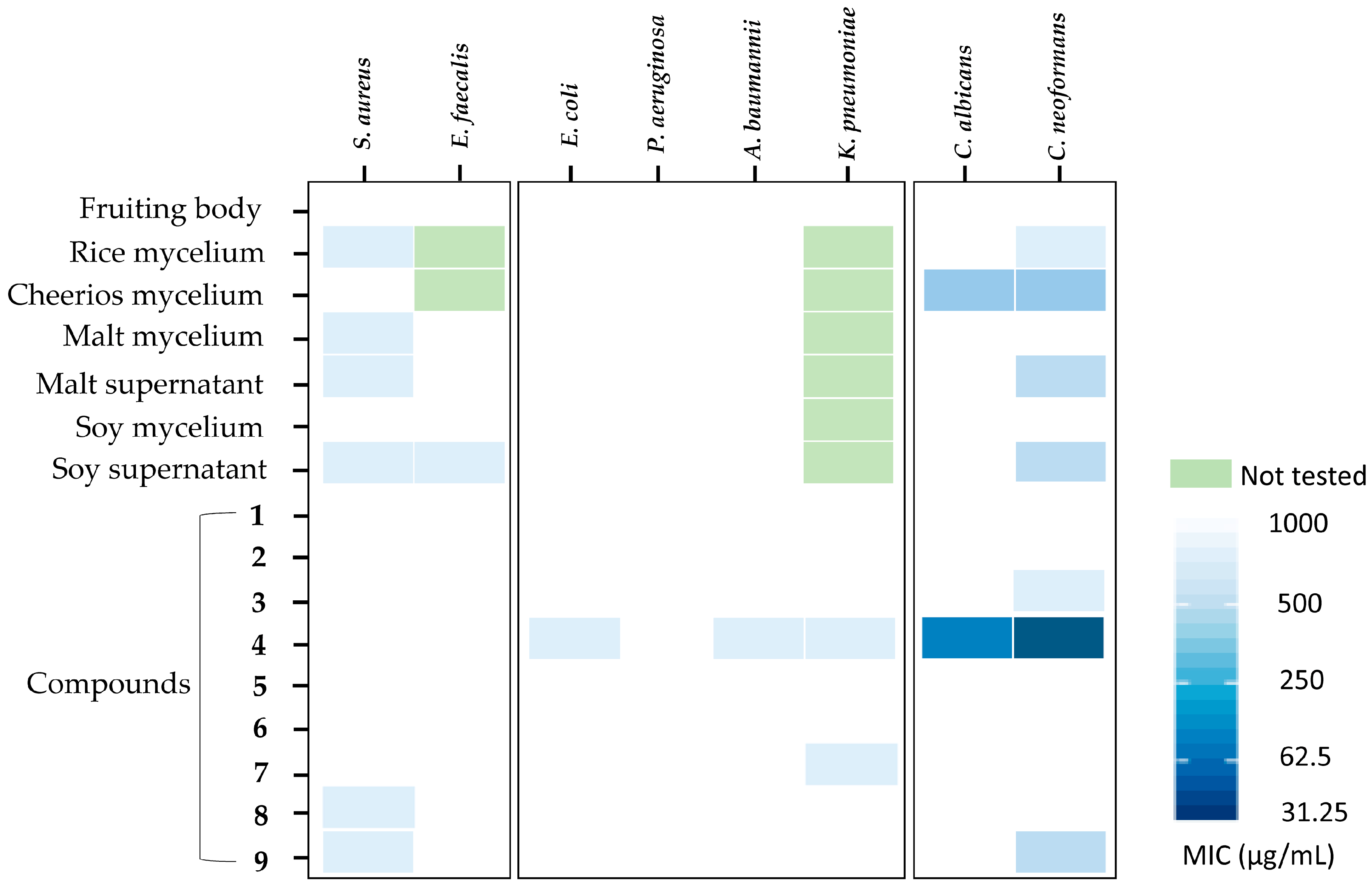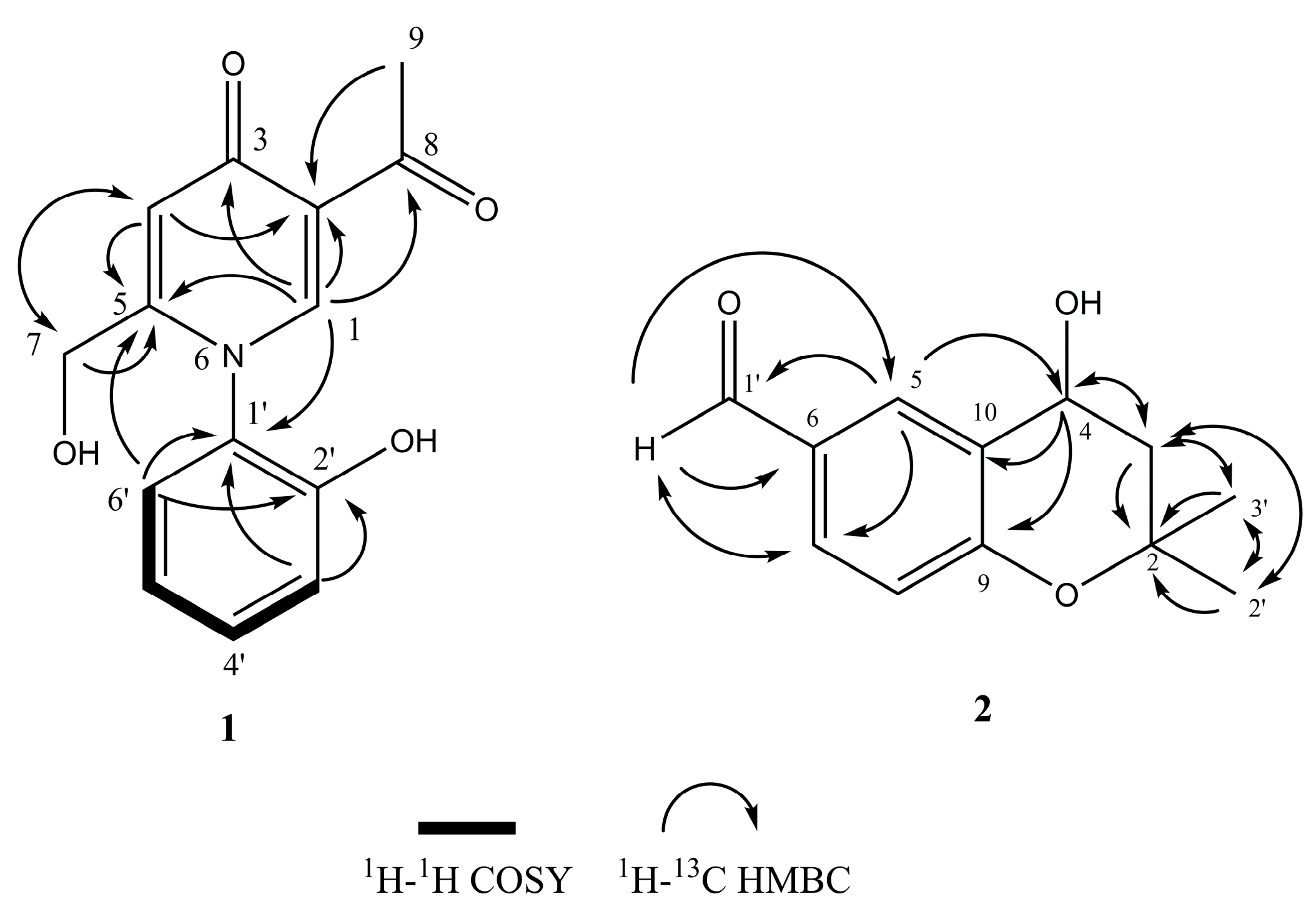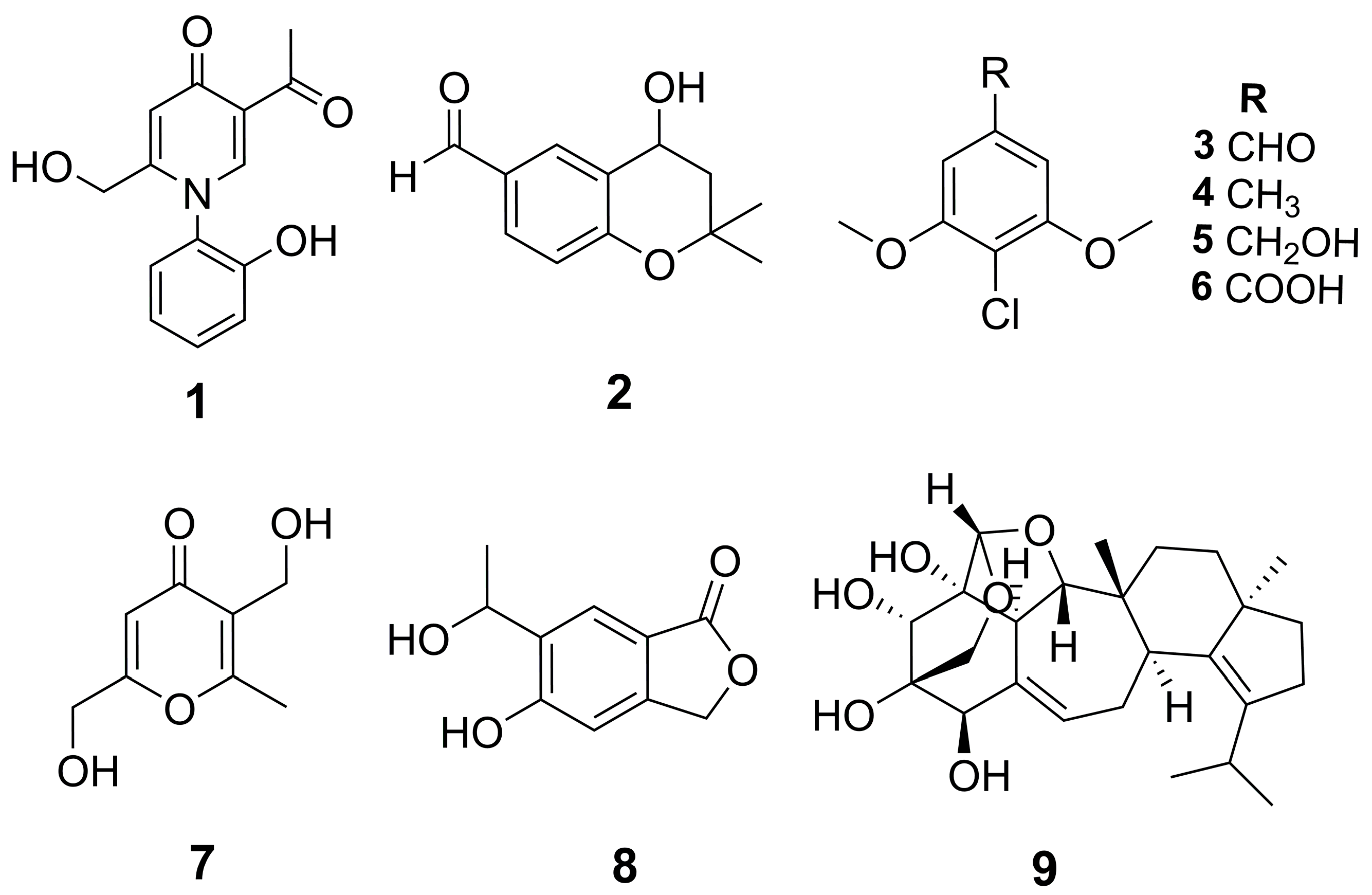Discovery of Antifungal and Biofilm Preventative Compounds from Mycelial Cultures of a Unique North American Hericium sp. Fungus
Abstract
1. Introduction
2. Results
2.1. Comparison of Chemical Profiles of Hericium sp. WBSP8 Extracts
2.2. Analysis of Antimicrobial Activities of Hericium sp. WBSP8 Extracts
2.3. Bioassay-Guided Isolation of Secondary Metabolites from Hericium sp. WBSP8 Grown on Cheerios
2.4. Structural Identification of Isolated Compounds
2.5. Antibacterial and Antifungal Activity of Isolated Compounds
2.6. Antibiofilm Activity of Compounds 1–9
3. Discussion
4. Materials and Methods
4.1. General Experimental Procedures
4.2. Mushroom Collection and Identification
4.3. Cultivations
4.4. Pathogens and Culture Conditions
4.5. Microbroth Dilution Assay
4.6. Tissue Culture Cytotoxicity Assays
4.7. Extractions and Compound Isolation
4.8. Biofilm Inhibition and Disruption Assays
4.9. Statistical Analysis
Supplementary Materials
Author Contributions
Funding
Acknowledgments
Conflicts of Interest
References
- Kodama, N.; Komuta, K.; Nanba, H. Effect of Maitake (Grifola frondosa) D-Fraction on the activation of NK cells in cancer patients. J. Med. Food 2003, 6, 371–377. [Google Scholar] [CrossRef] [PubMed]
- Guggenheim, A.G.; Wright, K.M.; Zwickey, H.L. Immune modulation from five major mushrooms: Application to integrative oncology. Integr. Med. 2014, 13, 32–44. [Google Scholar]
- Kamalebo, H.M.; Malale, H.N.S.W.; Ndabaga, C.M.; Degreef, J.; De Kesel, A. Uses and importance of wild fungi: Traditional knowledge from the Tshopo province in the Democratic Republic of the Congo. J. Ethnobiol. Ethnomed. 2018, 14. [Google Scholar] [CrossRef]
- Manzi, P.; Gambelli, L.; Marconi, S.; Vivanti, V.; Pizzoferrato, L. Nutrients in edible mushrooms: An inter-species comparative study. Food Chem. 1999, 65, 477–482. [Google Scholar] [CrossRef]
- Yamaç, M.; Bilgili, F. Antimicrobial activities of fruit bodies and/or mycelial cultures of some mushroom isolates. Pharm. Biol. 2006, 44, 660–667. [Google Scholar] [CrossRef]
- Blagodatski, A.; Yatsunskaya, M.; Mikhailova, V.; Tiasto, V.; Kagansky, A.; Katanaev, V.L. Medicinal mushrooms as an attractive new source of natural compounds for future cancer therapy. Oncotarget 2018, 9, 29259–29274. [Google Scholar] [CrossRef] [PubMed]
- Carhart-Harris, R.L.; Bolstridge, M.; Rucker, J.; Day, C.M.; Erritzoe, D.; Kaelen, M.; Bloomfield, M.; Rickard, J.A.; Forbes, B.; Feilding, A.; et al. Psilocybin with psychological support for treatment-resistant depression: An open-label feasibility study. Lancet. Psychiatry 2016, 3, 619–627. [Google Scholar] [CrossRef]
- Daniel, J.; Haberman, M. Clinical potential of psilocybin as a treatment for mental health conditions. Ment. Health Clin. 2017, 7, 24–28. [Google Scholar] [CrossRef]
- Spiteller, P. Chemical ecology of fungi. Nat. Prod. Rep. 2015, 32, 971–993. [Google Scholar] [CrossRef]
- Chen, H.P.; Liu, J.K. Secondary metabolites from higher fungi. Prog. Chem. Org. Nat. Prod. 2017, 106, 1–201. [Google Scholar]
- Künzler, M. How fungi defend themselves against microbial competitors and animal predators. PLoS Pathog. 2018, 14, e1007184. [Google Scholar] [CrossRef] [PubMed]
- Ujor, V.C.; Adukwu, E.C.; Okonkwo, C.C. Fungal wars: The underlying molecular repertoires of combating mycelia. Fungal Biol. 2018, 122, 191–202. [Google Scholar] [CrossRef] [PubMed]
- Rutledge, P.J.; Challis, G.L. Discovery of microbial natural products by activation of silent biosynthetic gene clusters. Nat. Rev. Microbiol 2015, 13, 509–523. [Google Scholar] [CrossRef] [PubMed]
- Stadler, M.; Sterner, O. Production of bioactive secondary metabolites in the fruit bodies of macrofungi as a response to injury. Phytochemistry 1998, 49, 1013–1019. [Google Scholar] [CrossRef]
- Pan, R.; Bai, X.L.; Chen, J.W.; Zhang, H.W.; Wang, H. Exploring Structural Diversity of Microbe Secondary Metabolites Using OSMAC Strategy: A Literature Review. Front. Microbiol 2019, 10. [Google Scholar] [CrossRef] [PubMed]
- Emberger, G. Hericium americanum. Available online: https://www.messiah.edu/Oakes/fungi_on_wood//teeth%20and%20spine/species%20pages/Hericium%20americanum.htm (accessed on 16 January 2020).
- Khan, M.A.; Tania, M.; Liu, R.; Rahman, M.M. Hericium erinaceus: An edible mushroom with medicinal values. J. Complementary Integr. Med. 2013, 10, 253–258. [Google Scholar] [CrossRef]
- Kushairi, N.; Phan, C.W.; Sabaratnam, V.; David, P.; Naidu, M. Lion’s Mane Mushroom, Hericium erinaceus (Bull.: Fr.) Pers. Suppresses H2O2-induced oxidative damage and LPS-induced inflammation in HT22 hippocampal neurons and BV2 microglia. Antioxid. (Baselswitz.) 2019, 8, 261. [Google Scholar] [CrossRef]
- Han, Z.H.; Ye, J.M.; Wang, G.F. Evaluation of in vivo antioxidant activity of Hericium erinaceus polysaccharides. Int. J. Biol. Macromol. 2013, 52, 66–71. [Google Scholar] [CrossRef]
- Kawagishi, H.; Ando, M.; Sakamoto, H.; Yoshida, S.; Ojima, F.; Ishiguro, Y.; Ukai, N.; Furukawa, S. Hericenones C, D and E, stimulators of nerve growth factor (NGF)-synthesis, from the mushroom Hericium erinaceum. Tetrahedron Lett. 1991, 32, 4561–4564. [Google Scholar] [CrossRef]
- Kenmoku, H.; Kato, N.; Shimada, M.; Omoto, M.; Mori, A.; Mitsuhashi, W.; Sassa, T. Isolation of (−)-cyatha-3,12-diene, a common biosynthetic intermediate of cyathane diterpenoids, from an erinacine-producing basidiomycete, Hericium erinaceum, and its formation in a cell-free system. Tetrahedron Lett. 2001, 42, 7439–7442. [Google Scholar] [CrossRef]
- Lee, E.W.; Shizuki, K.; Hosokawa, S.; Suzuki, M.; Suganuma, H.; Inakuma, T.; Li, J.; Ohnishi-Kameyama, M.; Nagata, T.; Furukawa, S.; et al. Two novel diterpenoids, erinacines H and I from the mycelia of Hericium erinaceum. Biosci. Biotechnol. Biochem. 2000, 64, 2402–2405. [Google Scholar] [CrossRef] [PubMed]
- Li, I.C.; Lee, L.Y.; Chen, Y.J.; Chou, M.Y.; Wang, M.F.; Chen, W.P.; Chen, Y.P.; Chen, C.C. Erinacine A-enriched Hericium erinaceus mycelia promotes longevity in Drosophila melanogaster and aged mice. PLoS ONE 2019, 14, e0217226. [Google Scholar] [CrossRef] [PubMed]
- Li, I.C.; Lee, L.Y.; Tzeng, T.T.; Chen, W.P.; Chen, Y.P.; Shiao, Y.J.; Chen, C.C. Neurohealth properties of Hericium erinaceus mycelia enriched with erinacines. Behav. Neurol. 2018, 2018, 5802634. [Google Scholar] [CrossRef] [PubMed]
- Host Defense Mushrooms. Available online: https://hostdefense.com/ (accessed on 26 November 2019).
- Wang, K.; Bao, L.; Ma, K.; Liu, N.; Huang, Y.; Ren, J.; Wang, W.; Liu, H. Eight new alkaloids with PTP1B and α-glucosidase inhibitory activities from the medicinal mushroom Hericium erinaceus. Tetrahedron 2015, 71, 9557–9563. [Google Scholar] [CrossRef]
- Kang, U.; Park, J.; Han, A.R.; Woo, M.H.; Lee, J.H.; Lee, S.K.; Chang, T.S.; Woo, H.A.; Seo, E.K. Identification of cytoprotective constituents of the flower buds of Tussilago farfara against glucose oxidase-induced oxidative stress in mouse fibroblast NIH3T3 cells and human keratinocyte HaCaT cells. Arch. Pharmacal Res. 2016, 39, 474–480. [Google Scholar] [CrossRef]
- Sun, J.; Yu, J.H.; Zhang, J.S.; Song, X.Q.; Bao, J.; Zhang, H. Chromane enantiomers from the flower buds of Tussilago farfara L. and assignments of their absolute configurations. Chem. Biodivers. 2019, 16, e1800581. [Google Scholar] [CrossRef]
- Okamoto, K.; Sakai, T.; Shimada, A.; Shirai, R.; Sakamoto, H.; Yoshida, S.; Ojima, F.; Ishiguro, Y.; Kawagishi, H. Antimicrobial chlorinated orcinol derivatives from mycelia of Hericium erinaceum. Phytochemistry 1993, 34, 1445–1446. [Google Scholar] [CrossRef]
- Qian, F.G.; Xu, G.Y.; Du, S.J.; Li, M.H. Isolation and identification of two new pyrone compounds from the culture of Hericium erinaceus. Yao Xue Xue Bao = Acta Pharm. Sin. 1990, 25, 522–525. [Google Scholar]
- Wu, J.; Tokunaga, T.; Kondo, M.; Ishigami, K.; Tokuyama, S.; Suzuki, T.; Choi, J.H.; Hirai, H.; Kawagishi, H. Erinaceolactones A to C, from the culture broth of Hericium erinaceus. J. Nat. Prod. 2015, 78, 155–158. [Google Scholar] [CrossRef]
- Kawagishi, H.; Shimada, A.; Hosokawa, S.; Mori, H.; Sakamoto, H.; Ishiguro, Y.; Sakemi, S.; Bordner, J.; Kojima, N.; Furukawa, S. Erinacines E, F, and G, stimulators of nerve growth factor (NGF)-synthesis, from the mycelia of Hericium erinaceum. Tetrahedron Lett. 1996, 37, 7399–7402. [Google Scholar] [CrossRef]
- de Melo, M.R.; Paccola-Meirelles, L.D.; Faria, T.D.; Ishikawa, N.K. Influence of Flammulina velutipes mycelia culture conditions on antimicrobial metabolite production. Mycoscience 2009, 50, 78–81. [Google Scholar] [CrossRef]
- VanderMolen, K.M.; Raja, H.A.; El-Elimat, T.; Oberlies, N.H. Evaluation of culture media for the production of secondary metabolites in a natural products screening program. Amb Express 2013, 3. [Google Scholar] [CrossRef] [PubMed]
- Van Kanegan, M.J.; Dunn, D.E.; Kaltenbach, L.S.; Shah, B.; He, D.N.; McCoy, D.D.; Yang, P.; Peng, J.; Shen, L.; Du, L.; et al. Dual activities of the anti-cancer drug candidate PBI-05204 provide neuroprotection in brain slice models for neurodegenerative diseases and stroke. Sci. Rep. 2016, 6, 25626. [Google Scholar] [CrossRef] [PubMed]
- Wang, K.; Chen, B.-S.; Bao, L.; Ma, K.; Han, J.-J.; Wang, Q.; Guo, S.-X.; Liu, H.-W. A review of research on the active secondary metabolites of Hericium species. MYCOSYSTEMA 2015, 34, 553–568. [Google Scholar]
- Xun, S.; Yi-Xuan, X.; Zhen-Dan, H.; Hong-Jie, Z. A review of natural products with anti-biofilm activity. Curr. Org. Chem. 2018, 22, 789–817. [Google Scholar]
- Martinez, L.R.; Casadevall, A. Biofilm formation by Cryptococcus neoformans. Microbiol. Spectr. 2015, 3. [Google Scholar] [CrossRef]
- Ramage, G.; Rajendran, R.; Sherry, L.; Williams, C. Fungal biofilm resistance. Int. J. Microbiol. 2012, 2012, 528521. [Google Scholar] [CrossRef]
- Martinez, L.R.; Mihu, M.R.; Han, G.; Frases, S.; Cordero, R.J.; Casadevall, A.; Friedman, A.J.; Friedman, J.M.; Nosanchuk, J.D. The use of chitosan to damage Cryptococcus neoformans biofilms. Biomaterials 2010, 31, 669–679. [Google Scholar] [CrossRef]
- Saitoh, K.-i.; Togashi, K.; Arie, T.; Teraoka, T. A simple method for a mini-preparation of fungal DNA. J. Gen. Plant. Pathol. 2006, 72, 348–350. [Google Scholar] [CrossRef]
- Manter, D.K.; Vivanco, J.M. Use of the ITS primers, ITS1F and ITS4, to characterize fungal abundance and diversity in mixed-template samples by qPCR and length heterogeneity analysis. J. Microbiol. Methods 2007, 71, 7–14. [Google Scholar] [CrossRef]
- Clinical and Laboratory Standards Institute. Performance Standards for Antimicrobial Susceptibility Testing, 14th Informational Suppl, M100-S14; NCCLS: Wayne, PA, USA, 2004. [Google Scholar]
- Mosmann, T. Rapid colorimetric assay for cellular growth and survival: Application to proliferation and cytotoxicity assays. J. Immunol. Methods 1983, 65, 55–63. [Google Scholar] [CrossRef]
- Lohse, M.B.; Gulati, M.; Valle Arevalo, A.; Fishburn, A.; Johnson, A.D.; Nobile, C.J. Assessment and optimizations of Candida albicans in vitro biofilm assays. Antimicrob. Agents Chemother. 2017, 61. [Google Scholar] [CrossRef] [PubMed]
Sample Availability: Samples of the compounds are not available from the authors. |




| Position | δC | δH (J in Hz) | COSY | HMBC |
|---|---|---|---|---|
| 1 | 149.0 | 8.11 (s, 1H) | C-2,3,5,8,1′ | |
| 2 | 126.2 | |||
| 3 | 179.8 | |||
| 4 | 119.3 | 6.86 (s, 1H) | C-2,5,7 | |
| 5 | 155.8 | |||
| 6 | ||||
| 7a | 60.3 | 4.17 (d, J = 15.5, 1H) | C- 4,5 | |
| b | 4.23 (d, J = 15.5, 1H) | |||
| 8 | 199.7 | |||
| 9 | 31.4 | 2.68 (s, 3H) | C-2,8 | |
| 1′ | 128.7 | |||
| 2′ | 154.0 | |||
| 3′ | 129.2 | 7.34 (dd, J = 7.9, 1.5, 1H) | H-4′ | C-1′,2′,4′ |
| 4′ | 133.2 | 7.49–7.41 (m, 1H) | H-3′,5′ | C-2′,3′ |
| 5′ | 121.5 | 7.10–7.01 (m, 1H) | H-4′,6′ | C-4′,6′ |
| 6′ | 118.1 | 7.10–7.01 (m, 1H) | H-5′ | C-1′,2′,4′,5′,5 |
| Position | δC | δH (J in Hz) | HMBC |
|---|---|---|---|
| 2 | 78.5 | ||
| 3a | 43.0 | 1.87 (dd, J = 13.4, 9.8, 1H, Ha-3) | C-2,4,10,2′,3′ |
| b | 2.24 (dd, J = 13.4, 6.1, 1H, Hb-3) | ||
| 4 | 63.5 | 4.96–4.86 (m, 1H) | C-3,9,10 |
| 5 | 132.4 | 8.07 (s, 1H) | C-4,6,7,9,10,1′ |
| 6 | 131.5 | ||
| 7 | 131.0 | 7.73 (dd, J = 8.5, 1.9, 1H) | C-6,9,1′ |
| 8 | 119.0 | 6.90 (d, J = 8.5, 1H) | C-6,7,9,10 |
| 9 | 160.6 | ||
| 10 | 127.2 | ||
| 1′ | 193.1 | 9.84 (s, 1H) | C-5,6,7 |
| 2′ | 29.7 | 1.48 (s, 3H) | C-2,3,3′ |
| 3′ | 26.1 | 1.36 (s, 3H) | C-2,3,2′ |
© 2020 by the authors. Licensee MDPI, Basel, Switzerland. This article is an open access article distributed under the terms and conditions of the Creative Commons Attribution (CC BY) license (http://creativecommons.org/licenses/by/4.0/).
Share and Cite
Song, X.; Gaascht, F.; Schmidt-Dannert, C.; Salomon, C.E. Discovery of Antifungal and Biofilm Preventative Compounds from Mycelial Cultures of a Unique North American Hericium sp. Fungus. Molecules 2020, 25, 963. https://doi.org/10.3390/molecules25040963
Song X, Gaascht F, Schmidt-Dannert C, Salomon CE. Discovery of Antifungal and Biofilm Preventative Compounds from Mycelial Cultures of a Unique North American Hericium sp. Fungus. Molecules. 2020; 25(4):963. https://doi.org/10.3390/molecules25040963
Chicago/Turabian StyleSong, Xun, François Gaascht, Claudia Schmidt-Dannert, and Christine E. Salomon. 2020. "Discovery of Antifungal and Biofilm Preventative Compounds from Mycelial Cultures of a Unique North American Hericium sp. Fungus" Molecules 25, no. 4: 963. https://doi.org/10.3390/molecules25040963
APA StyleSong, X., Gaascht, F., Schmidt-Dannert, C., & Salomon, C. E. (2020). Discovery of Antifungal and Biofilm Preventative Compounds from Mycelial Cultures of a Unique North American Hericium sp. Fungus. Molecules, 25(4), 963. https://doi.org/10.3390/molecules25040963








